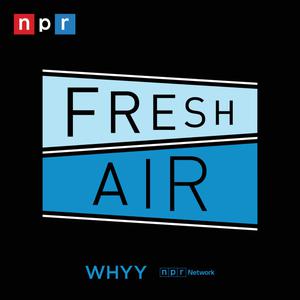
The Substack Podcast
The Substack team
Conversations with writers who have earned their independence.
- 4 minutes 28 secondsDear writer: Advice on creating a sacred writing space
We asked , who writes on Substack, for advice on making her new Substack sustainable, slowly and steadily cultivating a sacred space for exploring writing and ideas, and building her community.
Jamie is an author, designer, digital course creator, and creative consultant living in Los Angeles. Her debut novel, Main Character Energy, was published in September 2023 by the HarperCollins imprint Park Row Books. Her previous nonfiction memoir, Radically Content, is currently being developed into a feature film, and her digital course, Live with Intention, has helped over 1,300 people live more intentional lives. Her work has appeared in the HuffPost, Teen Vogue, and POPSUGAR and been shared by millions online. Read on for Jamie’s advice, or listen to her read it aloud in this episode.
This is the latest post in a recurring series of longform writer advice. To see more advice from Substack writers, take a look at previous posts here.
This is a public episode. If you would like to discuss this with other subscribers or get access to bonus episodes, visit on.substack.com4 October 2023, 1:30 pm - 14 minutes 48 secondsWhy Doomberg left Twitter (okay, X) to go all in on Substack
In early August, Doomberg, the leading publication in the finance category on Substack, announced that they were opting out of X (fka Twitter) and putting all their focus on Substack.
The Doomberg team had built much of their brand and reach on Twitter through a strategy that leaned on getting their goggle-eyed green chicken avatar in front of as many people as possible through timely tweets, threads, and storytelling around their Substack posts. They coupled this active Twitter presence with appearing on as many podcasts as they possibly could to deepen their relationship with finance-minded readers (listen to our interview with Doomberg for The Active Voice for more on that strategy).
Shifting their focus entirely to Substack, with an emphasis on Notes, was a bold move by the green chicken, but they say the decision was ultimately straightforward. They came to feel that X was operating against their interests, while Substack was directly aligned with them. “We settled on Notes because the team at Substack has been our partner from the beginning,” Doomberg wrote.
I got on a Zoom call with the green chicken to dive deeper into their thinking behind the move and explore what it says about long-term thinking. I hope some of these takeaways are useful for all independent writers. You can listen to the interview above, read the full transcript attached to this post, or enjoy a condensed version of the discussion below.
This is a public episode. If you would like to discuss this with other subscribers or get access to bonus episodes, visit on.substack.com4 September 2023, 3:00 pm - 4 minutes 1 secondIntroducing new audio transcription tools for Substack
We’ve just shipped some new features that make podcasting on Substack even better.
You can now use a special AI tool to create a clean transcript of your podcast episode or narration without having to do anything more than click a button.
The whole transcription process usually takes about a minute.
Once you’ve created the transcript, you can go in and edit it to make it just how you like it, and you can publish it in its own tab on the episode post page.
Then, you can select a passage that you can then use to generate a special audiogram that you can share to social media.
An audiogram is like a little static video with text and the audio playing over top. It’s a really neat asset to share to show off your podcast episode. (See the example below.)
We’ve done this all using cutting-edge AI tools, and it reflects our philosophy of not thinking that this AI stuff is ever going to take the place of work done by writers and creators—but instead we think it can give writers and creators super-powers.
In fact, this thing you’re reading right now is a transcript that we generated from the audio tool. I’m basically speaking off-the-cuff into a microphone and we’re using this as our announcement post. (Hopefully this technology can handle my New Zealand accent.)
To use these tools, you:
* Go into your dashboard
* Create an episode post
* Then, when you’re in editing mode, you upload your audio, and you’ll pretty quickly be presented with an option to generate the transcript.
* You click the “Generate Transcript” button and you wait a second, or maybe a minute, and then in very short order you have a beautiful transcript to work with.
* You can go in and review that transcript in the backend before you publish it, and you can edit it.
* When you publish it, there’s a default-on toggle that will make sure that the transcript will show up in the post alongside your episode. (You can also turn that off if you need to.)
* Once the transcript is published, you can select a passage and then click “Make audiogram” to generate the social sharing asset.
All of these tools are in their very early stages and they’re only going to get better and better. Stick with us for a while, because while they may not be perfect at first glance, they are going to rapidly evolve. We want you to have fun with them though, so we want to get this out to you sooner rather than later.
We already are getting great feedback from writers who are having a great time with this new tool.
For instance, Tony Mecia, who publishes The Charlotte Ledger, said the following about using the podcast tools: “The transcripts of the podcast are really, really good! Surprisingly good.”
He’s used other mainstream tools to do podcast transcriptions and found them not as fast and not as accurate.
And Bill Bishop, who publishes Sinocism, a China newsletter, the first ever publisher on Substack, he got early access to these features and he’s tried them with two podcasts, his Sinocism Podcast and his weekly Sharp China Podcast. He said he has tried several outside services for transcripts, both machine and human generated, and the Substack service, this one, was much better already than those other services he’s used.
So, go to your dashboard now, create an episode post. You’ll see the options to generate a transcript and you can start having fun.
We’re really interested in your feedback. As I said, these are the early days, so please leave a comment or send us an email or—you know—send us a podcast episode and link to it on Substack Notes.
Thanks everyone. Enjoy these new tools.
Add a podcast to your existing Substack or start a new one. Visit the Help Center to learn more about podcasting.
This is a public episode. If you would like to discuss this with other subscribers or get access to bonus episodes, visit on.substack.com30 August 2023, 4:55 pm - 6 minutes 7 secondsDear writer: Advice on conjuring good ideas
We asked , who writes on Substack, for advice on finding great ideas. Brian is a social scientist and professor of global politics at University College London. He is the author of four books, including Corruptible: Who Gets Power and How It Changes Us, which includes interviews with torture victims, CEOs, cult leaders, and more.
Brian’s Substack explores the mystery and marvel of the world we live in, and how evolutionary biology, history, neuroscience, anthropology, and philosophy relate to challenges we face today and our possible futures. He writes for The Atlantic, created the award-winning Power Corrupts podcast, and is a self-professed “history nerd,” offering guided tours in his local southern England. Read on for his advice, or listen to Brian read it aloud above.
This is the 13th in a recurring series of longform writer advice, following Kristen Hawley’s advice on facing the behemoths, Hilary Fitzgerald Campbell’s advice on prioritizing your to-do list, Lauren Wolfe’s advice on tackling difficult stories, Holly Whitaker’s advice on writing like it matters, Lucy Webster’s advice on writing from lived experience, Scott Hines’s advice on cultivating connection in the internet age, Robert Reich’s advice on sharing your personality, Helena Fitzgerald’s advice on isolation, Alicia Kennedy’s advice on learning to listen, Kate Lindsay’s advice on creating trust with your readers, Anna Codrea-Rado’s advice on learning to celebrate how far you’ve come, and Mason Currey’s advice on creative growth.
Could you use some advice or inspiration from a fellow writer about creativity, motivation, and the writing life? Submit your question for consideration for a future advice column by leaving it in the comments below.
This is a public episode. If you would like to discuss this with other subscribers or get access to bonus episodes, visit on.substack.com21 June 2023, 3:00 pm - 5 minutes 38 secondsDear writer: Advice on facing the behemoths
We asked for advice on thriving as an independent writer, even when your competitors loom large and attempt to swallow you whole. Kristen’s first newsletter—covering how technology was changing the restaurant industry—launched in 2013, was sold to a media company in 2016, and was killed in 2019. Five months later, she launched on Substack, where she writes about the future of hospitality.
Kristen writes for Bon Appétit, Food & Wine, Eater, and Insider, is a regular speaker at industry events, and has been featured as a restaurant expert in the New York Times, NBC News, and CBS News Radio. Read on for her advice, or listen to her read it aloud above.
This is the 12th in a recurring series of longform writer advice, following Hilary Fitzgerald Campbell’s advice on prioritizing your to-do list, Lauren Wolfe’s advice on tackling difficult stories, Holly Whitaker’s advice on writing like it matters, Lucy Webster’s advice on writing from lived experience, Scott Hines’s advice on cultivating connection in the internet age, Robert Reich’s advice on sharing your personality, Helena Fitzgerald’s advice on isolation, Alicia Kennedy’s advice on learning to listen, Kate Lindsay’s advice on creating trust with your readers, Anna Codrea-Rado’s advice on learning to celebrate how far you’ve come, and Mason Currey’s advice on creative growth.
Could you use some advice or inspiration from a fellow writer about creativity, motivation, and the writing life? Submit your question for consideration for a future advice column by leaving it in the comments below.
This is a public episode. If you would like to discuss this with other subscribers or get access to bonus episodes, visit on.substack.com9 June 2023, 2:00 pm - 2 minutes 58 secondsDear writer: Advice on prioritizing your to-do list
We asked the cartoonist, comedian, and author Hilary Fitzgerald Campbell for her advice on prioritizing growing to-do lists.
Hilary is the author of Murder Book, and her forthcoming book What Did I Do Today? is a guided journal for daily accomplishments. On her Substack, Cartoons by Hilary, she publishes illustrated advice columns, sketchbook dumps, and a podcast with Derek Boeckelmann to ask friends What did you do this weekend? Hilary is also a contributor to and the New Yorker. Read on for her illustrated response, and listen to hear her read her words aloud.
Dear writer, how do you prioritize all the things you want to do?
This is the eleventh in a recurring series of longform writer advice, following Lauren Wolfe’s advice on tackling difficult stories, Holly Whitaker’s advice on writing like it matters, Lucy Webster’s advice on writing from lived experience, Scott Hines’s advice on cultivating connection in the internet age, Robert Reich’s advice on sharing your personality, Helena Fitzgerald’s advice on isolation, Alicia Kennedy’s advice on learning to listen, Kate Lindsay’s advice on creating trust with your readers, Anna Codrea-Rado’s advice on learning to celebrate how far you’ve come, and Mason Currey’s advice on creative growth.
On Friday, January 6 at 7 am PST / 10 am EST we’re hosting a chat with Hilary On Substack. Hilary provided a prompt from her new book, What Did I Do Today?, for the writer community to respond to. Download the prompt via on.substack.com, write your response, snap a photo, and tune into the chat via the Substack app on Friday!
This is a public episode. If you would like to discuss this with other subscribers or get access to bonus episodes, visit on.substack.com4 January 2023, 2:00 pm - 6 minutes 32 secondsDear writer: Advice on tackling difficult stories
We asked for her advice on tackling heavy subject matter while keeping her audience engaged. Lauren is an award-winning journalist and photographer of more than 20 years. She spent more than a decade reporting from war zones in which women and girls are violated and, before that, five years documenting violence and the suppression of journalists globally.
She has written for The Atlantic and The Guardian and is a contributing writer for Washington Monthly and an adjunct professor at NYU’s graduate school of journalism. Lauren writes from the front line of conflict in her newsletter, , and gives a behind-the-scenes look at how dangerous investigative journalism gets made. Read on for her response.
This is the tenth in a recurring series of longform writer advice, following Holly Whitaker’s advice on writing like it matters, Lucy Webster’s advice on writing from lived experience, Scott Hines’s advice on cultivating connection in the internet age, Robert Reich’s advice on sharing your personality, Helena Fitzgerald’s advice on isolation, Alicia Kennedy’s advice on learning to listen, Kate Lindsay’s advice on creating trust with your readers, Anna Codrea-Rado’s advice on learning to celebrate how far you’ve come, and Mason Currey’s advice on creative growth.
This is a public episode. If you would like to discuss this with other subscribers or get access to bonus episodes, visit on.substack.com16 December 2022, 3:55 pm - 5 minutes 51 secondsDear Writer: Advice on writing like it matters
We asked Holly Whitaker to share advice on her writing practice. Holly writes Recovering, a newsletter that looks at recovery as a way of living that is accessible to everyone. Holly started blogging in 2013 after going sober, which turned into a sobriety school, a digital recovery startup, and New York Times bestseller Quit Like a Woman. She is also working on her second book and a podcast. Read on for her advice, or listen to her read it aloud.
Dear writer, how does your Substack fit into your wider writing practice and online presence?
Before I knew I was a writer, I was an accountant. My job title was Director of Revenue Cycle Management Operations, and the only essays I wrote were soul-destroying emails I cc’d your boss on. If you would have told me back then that one day I’d be explaining how something called a “Substack” fits into my “writing practice” and “online presence,” I would have done what I did the other night at a comedy show, which is spit on someone. Because of laughing.
But that’s where it started. I was wearing lots of Ann Taylor Loft and formatting spreadsheets by day, and by night—because I was newly sober and exploding inside and having to pretend everything was normal over here, and there was nothing to see, folks—I wrote for a WordPress site, anonymously. I start my answer there because that’s where it counts and what I want you to get from this answer. I didn’t start writing to build an online presence or even to have a writing practice, but because I needed to write. I had to write. I didn’t know what else to do. I was lost. I was alone. I was stuck in the wrong life. I had a lot to say and I didn’t know who to say it to. That was 2013.
“I didn’t start writing to build an online presence or even to have a writing practice, but because I needed to write. I had to write.”
In 2021, by then a New York Times best-selling author and someone who had been featured in Vogue multiple times and had sold hundreds of thousands of books and counted among her assets a very loyal and large social media following, I grabbed a Substack handle for the same reasons I secured that WordPress domain way back when: I was lost, I was alone, I was stuck in the wrong life. I had a lot to say and I didn’t know who to say it to.
What I mean to tell you, fellow writer, is that I didn’t start a Substack as a strategy, as a way to hone my writing chops or build a brand or make a living. I started it out of desperation, as a lifeline. Much like 2013 and the now-defunct littlemisssurrendered.com, Substack was the only thing that made sense, and even that makes it sound like it was more planned than it actually was.
When I say I was lost (in 2021), I mean I was not sure what I stood for anymore. I’d recently been squeezed out of an organization I founded; I’d lost many of my friends; I lived alone in the woods on a dead end road, and my cat was who I talked to the most, and my identity was hanging in a closet somewhere. My head was a soupy mess of ideas, and my thought loop was nihilistic, and everything I believed in felt fraught, and I was scared I’d written myself into a corner or that maybe I had peaked and it was all downhill from there. Back then, the thing that felt so great about Substack was that it wasn’t some blog people might attend or even a Mailchimp that might turn into a sales pitch. Substack was a place where readers had to figure out how to sign up, a place where they had to agree to get your emails on a regular basis, a place with barriers to entry, (in some cases) a cover charge, and those things were not available on social media or a blog site. People had to want to read me, effort to read me, and in some way all that made my writing holy again. It created a boundary, a haven, a netting between myself and the scant few that might follow me here from places where I was more well known and my art was consumed in the blur of a scroll. Here, I started to experiment with a different voice that felt closer to my own. Here, I started to test out what it might feel like to write instead of catch eyes. Here, I got honest in a way that I don’t think I’d been anywhere else. Here, I started charging for my words, daring to believe that my writing wasn’t some side project but the main event. In 2021, trying to figure out what to do with the rest of my life, I thought “maybe writer.” Some 50 Substack essays later, I think “writer.”
What has been so delicious about writing on Substack is that it isn’t something that fits into my wider writing practice, like some piece of a puzzle—it is my writing practice. Writing here also isn’t something that fits into my wider online presence, because in being here, I have learned that an online presence isn’t something I care to curate the same way I once did, if at all.
Read more: #1 Being All Of It
I think we ask people things like I am being asked because we want to know the formula, the juice, how to replicate or establish or build. We are conditioned to believe that it doesn’t matter unless there are clicks, impressions, likes, comments, engagement; that our work doesn’t matter unless we’re known. I’ve been successful in the measurable ways because I followed those playbooks, but that has always left me miserable. Here, I have not followed the playbooks, I have done a lot of it wrong, but I have written like it matters, like what I have to say matters. If there’s any advice I have to give, it’s that. Sure, pay attention to the technical bits, the hacks and the best practices, and drive your engagement and whatever. But write like it matters and like what you have to say matters. Write like it’s 2013 and no one knows who the hell you are or cares what you have to say, and do it anyway.
Sincerely and truly yours,
Holly Glenn Whitaker
Subscribe to Recovering on Substack, and you can also find Holly on Instagram and her personal website.
This is a public episode. If you would like to discuss this with other subscribers or get access to bonus episodes, visit on.substack.com1 November 2022, 3:00 pm - 4 minutes 3 secondsIntroducing The Active Voice, a new podcast about writing and the internet
Welcome to our new podcast, The Active Voice. It's about how great writers are reckoning with the challenges of the social media moment, how they find the space for themselves to create great literature and journalism despite the noise, and how to make a living amid the economic volatility of the 2020s.
In the first episode, Substack co-founder Hamish McKenzie talks to George Saunders, one of America’s greatest living writers (and author of the wonderful Substack Story Club). You can listen to it and subscribe at read.substack.com.
This podcast is called The Active Voice because we enjoy the double entendre, and because it is about the writer in the arena: the writer who, despite the pressures of the social media moment, has the courage to say what they believe needs to be said; the writer who finds a way to speak truth to power; the writer who seeks understanding over takedowns. This podcast is for those who know that what you read matters and that great writing is valuable.
I can’t wait to share all these conversations with you.
The Active Voice is produced and shared using Substack for podcasts. Find out how Substack makes a richer podcasting experience, supporting multimedia and subscriptions, and fostering a direct relationship with your listeners here.
This is a public episode. If you would like to discuss this with other subscribers or get access to bonus episodes, visit on.substack.com20 October 2022, 10:45 am - 5 minutes 32 secondsDear Writer: Advice on bringing your unique skills together
We asked Robert Reich to share his advice on learning to use his writing and drawing skills to illustrate his Substack. Read on for Robert’s advice, or listen to him read it aloud above.
This is the fifth in a recurring series of longform writer advice, following Alicia Kennedy’s advise on learning to listen, Embedded’s Kate Lindsay’s advice on creating trust with your readers, Lance’s Anna Codrea-Rado’s advice on learning to celebrate just how far you’ve come, and Mason Currey’s advice on creative growth.
Could you use some advice or inspiration from a fellow writer about creativity, motivation, and the writing life? Submit your question for consideration for a future advice column by leaving it in the comments below.
This is a public episode. If you would like to discuss this with other subscribers or get access to bonus episodes, visit on.substack.com9 June 2022, 2:19 pm - 6 minutes 38 secondsDear Writer: Advice on writing through isolation
We asked Helena Fitzgerald to share her advice on navigating isolation as a writer. Helena writes Griefbacon—a newsletter on the weirdness of relationships for “the last people at the party after everyone else has gone home.” Listen on for her experience of solitude in writing, or listen to her read it aloud above.
Dear writer, how does isolation play into your writing experience? When do you crave it, and at what point do you seek support, collaboration, or edits? How do you come up for air when the loneliness of writing becomes too much?
*This is the fifth in a recurring series of longform writer advice, following Alicia Kennedy’s advice on learning to listen, Embedded’s Kate Lindsay’s advice on creating trust with your readers, Lance’s Anna Codrea-Rado’s advice on learning to celebrate just how far you’ve come, and Mason Currey’s advice on creative growth.
Could you use some advice or inspiration from a fellow writer about creativity, motivation, and the writing life? Submit your question for consideration for a future advice column by leaving it in the comments on Substack.
This is a public episode. If you would like to discuss this with other subscribers or get access to bonus episodes, visit on.substack.com6 June 2022, 3:00 pm - More Episodes? Get the App
Your feedback is valuable to us. Should you encounter any bugs, glitches, lack of functionality or other problems, please email us on [email protected] or join Moon.FM Telegram Group where you can talk directly to the dev team who are happy to answer any queries.
 Hidden Brain
Hidden Brain
 The New Yorker Radio Hour
The New Yorker Radio Hour
 The Daily
The Daily
 The Daily Show: Ears Edition
The Daily Show: Ears Edition
 Fresh Air
Fresh Air
 The Rachel Maddow Show
The Rachel Maddow Show